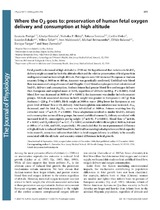Where the O2 goes to : preservation of human fetal oxygen delivery and consumption at high altitude

View/
Date
2009Author
Postigo, Lucrecia
Heredia, Gladys
Illsley, Nicholas P
Torricos, Tatiana
Dolan, Caitlin
Echalar, Lourdes
Téllez, Wilma
Maldonado, Iván
Brimacombe, Michael
Balanza, Elfride
Vargas, Enrique
Zamudio, Stacy
Metadata
Show full item recordAbstract
Fetal growth is decreased at high altitude (> 2700 m). We hypothesized that variation in fetal O2
delivery might account for both the altitude effect and the relative preservation of fetal growth in
multigenerational natives to high altitude. Participants were 168 women of European or Andean
ancestry living at 3600 m or 400 m. Ancestry was genetically confirmed. Umbilical vein blood
flow was measured using ultrasound and Doppler. Cord blood samples permitted calculation of
fetal O2 delivery and consumption. Andean fetuses had greater blood flow and oxygen delivery
than Europeans and weighed more at birth, regardless of altitude (+208 g, P < 0.0001). Fetal
blood flow was decreased at 3600 m (P < 0.0001); the decrement was similar in both ancestry
groups. Altitude-associated decrease in birth weight was greater in Europeans (−417 g) than
Andeans (−228 g, P < 0.005). Birth weight at 3600 m was > 200 g lower for Europeans at any
given level of blood flow or O2 delivery. Fetal haemoglobin concentration was increased, P CO2
decreased, and the fetal P O2/SO2 curve was left-shifted at 3600 m. Fetuses receiving less O2
extracted more (r2 = 0.35, P < 0.0001). These adaptations resulted in similar fetal O2 delivery
and consumption across all four groups. Increased umbilical venous O2 delivery correlated with
increased fetal O2 consumption per kg weight (r2 = 0.50, P < 0.0001). Blood flow (r2 = 0.16,
P < 0.001) and O2 delivery (r2 = 0.17, P < 0.001) correlated with birth weight at 3600 m, but not
at 400 m (r2 = 0.04, and 0.03, respectively). We concluded that the most pronounced difference
at high altitude is reduced fetal blood flow, but fetal haematological adaptation and fetal capacity
to increase O2 extraction indicates that deficit in fetal oxygen delivery is unlikely to be causally
associated with the altitude- and ancestry-related differences in fetal growth.
